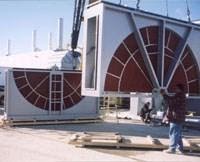 The Challenge
The Challenge
A recreational products company bought a three year-old manufacturing facility with an existing Regenerative Thermal Oxidizer (RTO) for the production of their outboard engines. They required emission control equipment to manage the Volatile Organic Compounds (VOCs) emitted by the solvents used in the engine painting processes. The company wanted to minimize overall costs by utilizing the existing RTO to control their emissions. However, the paint exhaust produced 80,000 SCFM (128,400 Nm3/hr), an impossible challenge for the existing RTO, which had been designed and built to control only 17,000 SCFM (27,285 Nm3/hr). Looking towards the future, the company wanted an air pollution control system capable of managing future expansion.
The Solution
Anguil’s engineering team demonstrated a solution that allowed the company to utilize the 17,000 SCFM (27,285 Nm3/hr) RTO that came with the building. By placing two 40,000 SCFM (64,200 Nm3/hr) Rotor Concentrators upstream from the RTO, the company could cost-effectively expand their operation and still achieve regulatory compliance.
 The Result
The Result
The outboard engine manufacturing plant operated multiple paint spray booths and ovens producing 80,000 SCFM (128,400 Nm3/hr) of exhaust air. Controlling the high-temperature oven exhaust alone would have ruled out VOC adsorption technologies, however, by combining the booth and oven exhausts, Anguil implemented an integrated VOC concentrator/oxidizer system that reduced the total exhaust flow from 80,000 SCFM to 8,000 SCFM. This enabled continued use of the existing regenerative thermal oxidizer (RTO).
The spray booth and oven exhausts were routed through a concentrator system where VOCs were adsorbed onto zeolite-coated honeycomb media. The VOCs were then desorbed from the concentrator wheel using an airflow one-tenth of the original volume. This led to the VOC concentration being approximately 10 times higher than the initial air stream. This smaller, more concentrated stream was treated in the oxidizer. This significantly reduced both capital expenses and operating costs.
Many concentrator/oxidizer system use oxidizer exhaust heat for desorption; the RTO’s high efficiency resulted in a low outlet temperature unsuitable for heat recovery. In order to maintain energy efficiency and performance, a dedicated heat source was installed specifically for the concentrator desorption.
The existing RTO required mechanical and electrical upgrades to allow for the integration of the concentrator. Anguil’s modification minimized the overall project cost and delivered the following benefits:
- Increased process capacity: Low desorption flow enabled the connection of additional process lines to the existing RTO.
- Automated integrated controls: Controls were designed for insurance and safety compliance, with remote telemetry for monitoring.
- Extended equipment life: Re-insulation of the RTO eliminated hot spots.
- Improved VOC destruction: Repairs to valves reduced leakage, and control valve captured/oxidized the VOC “spike” typical of two-chamber RTO installations.
- Lower operating costs and emissions: Supplemental fuel injection (SFI) reduced auxiliary fuel needs and significantly cut NOx output.

